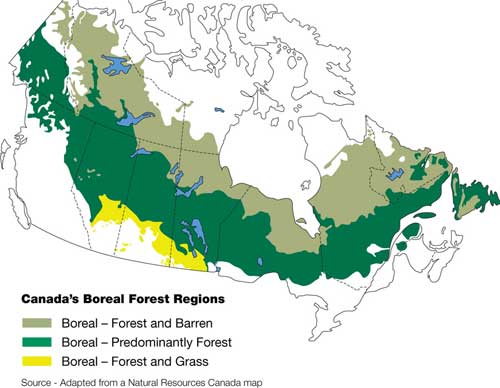Boreal Forest
Most of the virgin fiber consumed by Resolute Forest Products’ operations in Canada is sourced from the company’s managed forests, which grow primarily on publicly owned land under provincial licenses in Canada's boreal forest. General information on fiber sourcing, including the purchased fiber processed in our U.S. operations and recovered fiber used to make 100% recycled pulp, is available on the Forestry and Fiber Sourcing page.
The boreal forest is a diverse ecological system that includes forests, wetlands, grasslands, tundra and rivers. Our forest management practices in the boreal forest are governed by stringent government environmental standards and regulations designed to promote healthy, sustainable forests – balancing environmental, social and economic values.
For decades, Resolute has worked with governments, communities, Indigenous Peoples and other stakeholders to protect wildlife habitats, breeding grounds and unique or culturally important ecosystems in the boreal forest.
Facts about the Boreal Forest

- The world's largest land-based ecosystem, the boreal forest circles the upper part of the northern hemisphere and covers 31% of Canada.
- The boreal forest is primarily an evergreen forest (spruce, pine, fir).
- 28% of the world's boreal forest is located in Canada.
- Canada retains about 90% of its original forest cover. Of the 10% that is gone, most has been lost to agriculture and urbanization – not forestry practices.
For more information, visit the Natural Resources Canada website.
Sustainability in the Boreal Forest
Resolute operates in a highly regulated environment with active enforcement by federal, provincial and local government partners. Forest management practices include defining protected areas, deferring forest management activities on selected large tracts, developing road management strategies (including road decommissioning), and ensuring 100% forest regeneration. In high conservation value forests, harvesting is not prohibited as long as effective strategies are in place to protect the high-value attributes that have been identified in collaboration with stakeholders and Indigenous Peoples.
In the boreal forest of Ontario and Quebec, where Resolute tenures are located, biodiversity monitoring is usually carried out by the provincial agencies responsible for wildlife policies and wildlife management. 100% of the woodlands we manage are certified to at least one independent certification standard, such as the Sustainable Forestry Initiative® (SFI®) and the Forest Stewardship Council® (FSC®), that require us to consider the latest scientific evidence on species conservation and management. Resolute is the largest holder of SFI and FSC forest management certification globally.
According to the United Nations Food and Agriculture Organization’s 2020 Global Forest Resources Assessment, forest cover in North America is stable, and the Canadian boreal forest is not a contributing factor to deforestation. The 2022 State of Canada’s Forests Report explains that just 0.2% of Canada’s forest is harvested each year – almost 33 times less than what is disturbed annually by natural causes such as forest fires, insects and disease. Canada’s annual deforestation rate, the permanent removal of forest cover from an area, is a mere 0.01%, resulting from industrial activities other than forestry (such as hydroelectricity), urban development and agriculture, which remains the largest contributor to deforestation in Canada.
Forest Regeneration
In Canada, woodlands must be promptly regenerated by law. The boreal forest has a remarkable ability to regenerate on its own. In fact, approximately 75% of the area harvested grows back naturally. Our foresters ensure that the rest is promptly reforested via seeding or planting of seedlings.
In 2012, Resolute planted its one billionth tree, and in 2015, we participated in the Sustainable Forestry Initiative’s world-record attempt to plant the most trees in one hour. Through our Ontario woodlands operations, we are contributing to the Canadian government’s 2 Billion Trees (2BT) commitment by planting approximately 300,000 trees to revegetate roads and gravel pits in areas where we previously had forest operations in Northwestern Ontario.